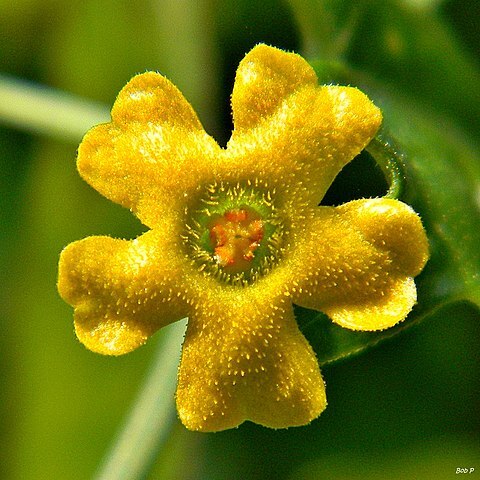Low climbers, subannual, leafy stem 1-1.5(-2) mm diam., green on drying; monoecious. Probract absent. Tendrils unbranched, glabrescent. Leaves simple, unlobed or lobed, palminerved. Flowers small, 5(-8) mm diam., yellow; sepals minute, narrow, subpatent; petals free, ovate-elliptic, valvate in bud; receptacle-tube campanulate. Male inflorescence a slender peduncled raceme, with congested flowers, mostly with 1 female flower co-axillary. Bracts absent. Male flowers: receptacle-tube cup-shaped; stamens 3, inserted at c. 1/3 below the throat of the receptacle-tube, filaments free, short, dorsifixed near apex, anthers two 2-thecous, one 1-thecous, included, thecae lateral, straight, connective narrow, not produced; disc subglobose. Female flowers solitary or co-axillary with male raceme; pedicel long; ovary (ellipsoid-)narrowly ovoid, with a slender neck; stigma consisting of 3 erect carnose lobes, papillose; staminodes 3, minute; disc annular, free from the receptacle-tube. Fruit solitary, with long slender fruiting pedicel, ellipsoid, small, 1-1.5 cm long, glabrous, juicy. Seeds numerous, compressed, ovate-elliptic, not sculptured, margin absent, not winged, edge entire.
Monoecious, tendriled vines; stems 5-to 10-sulcate. Leaves petiolate, simple, entire or lobate; tendrils simple. Staminate flowers axillary, racemose; calyx campanulate to subcylindric, 5-lobate; corolla yellow or white, deeply 5-lobate; stamens 3, free, inserted on the hypanthium wall, the anthers oblong or suborbic-ular, 1 unilocular, 2 bilocular; pistillode globose or conic. Pistillate flowers soli-tary; calyx and corolla as in the staminate flowers; ovary ovoid to fusiform, 3-carpellate, the ovules numerous, horizontal, the styles 3, connate, short, the base surrounded by a ringlike disc, the stigmas 3, linear; staminodia 3. Fruit ovoid to fusiform; seeds ovoid or ellipsoidal, compressed, sericeous.
Herbs, climbing or trailing, annual. Leaves petiolate, usually palmately lobed. Tendrils simple. Plants monoecious. Male flowers shortly racemose or subcorymbose; calyx campanulate to cylindrical, 5-lobed; corolla yellow, rotate; segments 5; stamens 3, inserted above middle of tube; anthers two 2-celled, one 1-celled; anther cells straight or slightly curved; connective not produced; rudimentary ovary subglobose. Female flowers solitary, usually coaxillary with male flowers; calyx and corolla as in male flowers; ovary globose to fusiform, 3-locular; ovules numerous, horizontal; style surrounded at base by an annular disk; stigmas 3. Fruit globose to oblong. Seeds numerous, compressed, smooth.
Monoecious; cal campanulate, 5-dentate; cor small, campanulate, 5-lobed; stamens apparently 3, the short filaments distinct, the straight, oblong anthers distinct or barely connivent; hypanthium greatly constricted above the 3-locular ovary; ovules numerous; style short, with 3 slender stigmas; fr pulpy, with numerous horizontal seeds; climbing herbs, with mostly undivided tendrils, the very small fls solitary or in small clusters. 10, New World.

